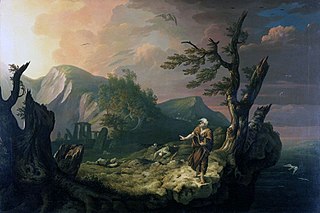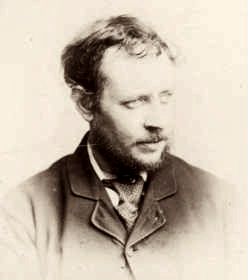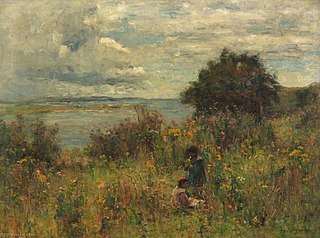The Royal Cambrian Academy of Art (RCA [1] ) is a centre of excellence for art in Wales. Its main gallery is located in Conwy and it has over a hundred members.
Contents

The Royal Cambrian Academy of Art (RCA [1] ) is a centre of excellence for art in Wales. Its main gallery is located in Conwy and it has over a hundred members.

During the 19th century there were numerous attempts to establish an academy in Wales comparable to those already in existence in England, Scotland and Ireland. [2] The Royal Cambrian Academy of Art was eventually founded in 1881, by a group of mainly English painters led by Henry Clarence Whaite, many of whom were now based in the Conwy Valley. [2] The group of 31 founding members included Bernard Walter Evans. [3] Ever since political unrest had made the Grand Tour hazardous for travellers, the wilds of North Wales became a fashionable alternative for English artists, [1] in particular the area around Betws-y-Coed which attracted the likes of David Cox. [4] The coming of the railways later aided artists from Liverpool and Manchester in transporting their art materials to Wales. [1] These artists arranged to meet a group of like-minded Welsh artists at Llandudno Junction, and from this meeting a group was formed called the Cambrian Academy of Art. [1]
Although they had no permanent gallery, they circulated their prospectus to other artists in Wales and their numbers began to grow. [1] Initially they only exhibited their work in north Wales, but they later extended membership to the south of the country. [1] The Academy's rapid growth was recognised the year after its formation, when in 1882 Queen Victoria commanded that it should be styled the 'Royal' Cambrian Academy of Art. Originally based in Llandudno, where there were already a number of commercial art galleries in the town, catering for the growing tourist trade, the academy later moved its operations to Plas Mawr in Conwy. [2] Plas Mawr, an Elizabethan town house which the Academy shared with a local junior school, was offered to the group under lease by Lord Mostyn. [1] The town house, which at the time was in a state of neglect, was restored by the Academy. Although an impressive historic building, Plas Mawr was not a natural gallery, and in 1896 an annexe was added to house the Victoria Gallery.
In 1934 the Royal Cambrian Academy gained one of its most notable Presidents, when Augustus John accepted the role, holding the title until 1939. In 1994, inspired by the efforts of their then President, Sir Kyffin Williams, the Academy broke its ties with Plas Mawr opening a new gallery close to their old headquarters in Conwy. [5]
The Academy's present President is Jeremy Yates and Vice President is Ann Lewis, while its patron is Charles, Prince of Wales. [1]

Blaenau Ffestiniog is a town in Gwynedd, Wales. Once a slate mining centre in historic Merionethshire, it now relies much on tourists, drawn for instance to the Ffestiniog Railway and Llechwedd Slate Caverns. It reached a population of 12,000 at the peak development of the slate industry, but fell with the decline in demand for slate. The population of the community, including the nearby village Llan Ffestiniog, was 4,875 in the 2011 census: the fourth most populous in Gwynedd after Bangor, Caernarfon and Llandeiniolen. The population not including Llan is now only about 4,000.

Llandudno is a seaside resort, town and community in Conwy County Borough, Wales, located on the Creuddyn peninsula, which protrudes into the Irish Sea. In the 2011 UK census, the community – which includes Gogarth, Penrhyn Bay, Craigside, Glanwydden, Penrhynside, and Bryn Pydew – had a population of 20,701. The town's name means "Church of Saint Tudno".

Conwy, previously known in English as Conway, is a walled market town, community and the administrative centre of Conwy County Borough in North Wales. The walled town and castle stand on the west bank of the River Conwy, facing Deganwy on the east bank. The town formerly lay in Gwynedd and prior to that in Caernarfonshire. The community, which also includes Deganwy and Llandudno Junction, had a population of 14,753 at the 2011 census.

Llanbedr-y-Cennin is a small village in Conwy county borough, Wales, in the community of Caerhun.

Sir John Kyffin Williams, was a Welsh landscape painter who lived at Pwllfanogl, Llanfairpwll, on the Island of Anglesey. Williams is widely regarded as the defining artist of Wales during the 20th century.

Tal-y-Bont is a small village in Conwy County Borough, Wales and lies in the Conwy Valley, west of the River Conwy, on the B5106 road, 6 mi (9.7 km) from the town of Conwy to the north, and six miles from Llanrwst to the south, and in the community of Caerhun. It lies adjacent to the village of Dolgarrog to the south, and below the small settlement of Llanbedr-y-Cennin to the west. The population is around 400.

Plas Mawr is an Elizabethan townhouse in Conwy, North Wales, dating from the 16th century. The property was built by Robert Wynn, a member of the local gentry, following his marriage to his first wife, Dorothy Griffith. Plas Mawr occupied a plot of land off Conwy's High Street and was constructed in three phases between 1576 and 1585 at a total cost of around £800. Wynn was known for his hospitality, and the household was supported by Wynn's local dairy herds, orchards and gardens. On his death he laid out complex instructions for dividing his estate; the resulting law-case took years to resolve, effectively preventing the redevelopment of the house and preserving it in its original condition.

Welsh art is the traditions in the visual arts associated with Wales and its people. Most art found in, or connected with, Wales is essentially a regional variant of the forms and styles of the rest of the British Isles, a very different situation from that of Welsh literature. The term Art in Wales is often used in the absence of a clear sense of what "Welsh art" is, and to include the very large body of work, especially in landscape art, produced by non-Welsh artists in Wales since the later 18th century.

Henry Clarence Whaite often referred to as Clarence Whaite (1828–1912) was an English artist best known for his landscape paintings of Wales. Having spent the earlier part of career based in his native Manchester, he later settled near Conwy in North Wales. He was an early member of the Manchester Academy of Fine Arts, and a leading figure in the formation of the Royal Cambrian Academy of Art.
The Manchester School of Painters was formed by a number of disgruntled young vanguard painters in the 1870s. They were deeply influenced by the artist Joseph Knight, who was a successful painter, etcher and photographer. He was the founder member of the Manchester School of Painters. Knight painted how he desired and refused to conform to traditional Art School rules and this appealed to his young admirers. Twice weekly they would all meet up at Knight's studio in York Place behind the Union Chapel in Oxford Road, Manchester to discuss new ways to develop their techniques.
Shani Rhys James MBE is a Welsh painter based in Llangadfan, Powys. She has been described as "arguably one of the most exciting and successful painters of her generation" and "one of Wales’ most significant living artists". She was elected to the Royal Cambrian Academy of Art in 1994. In the 2006 New Years Honours she was appointed Member of the Order of the British Empire (MBE) for "services to art".

Julius Hare RCA was a British artist, painter of portraits and landscapes.
The Welsh Group is an artists' collective, with the purpose of exhibiting and "giving a voice" to the visual arts in Wales.

Art in Cardiff refers to the culture of visual arts in Cardiff, capital city of Wales. The visual arts in Cardiff have a much more recent history than many British cities, due to it being a very small town until rapid growth took place in the mid nineteenth century. Cardiff School of Art originated in 1865 and the first major public art exhibition took place in 1870. The town became a city in 1905, after which time it gained further importance, for example with the creation of a new National Museum. Into the 21st century it has a thriving art scene.

Mostyn is a public art gallery in Llandudno, North Wales. It was previously called Oriel Mostyn but was rebranded as simply Mostyn following its 2010 revamp.
Vincent Evans (1896–1976) was a Welsh artist who had a varied career as a painter, printmaker and art teacher and is known for his depictions of mine workers.
Mildred Elsie Eldridge known as Elsi Eldridge, was a British artist, mural painter and book illustrator.

Bernard Walter Evans was a British landscape painter and watercolourist in the Romantic style, working mainly in Birmingham, Wales, London, Cannes and the North Riding of Yorkshire. Because he used a "heavy, cumbrous" horse-drawn van to reach remote sites in Yorkshire, his nickname there was Van Evans, and he was recognisable with his wideawake hat, pipe and neckerchief. He was known for his arduous days of painting in the hard Yorkshire winters, with frozen water pots, little food, and only a paraffin stove to warm his hands.

Joshua Anderson Hague (1850–1916) is recognized as an important Victorian painter of scenery in the Welsh countryside. He was a founding member and vice president of the Royal Cambrian Academy of Art.